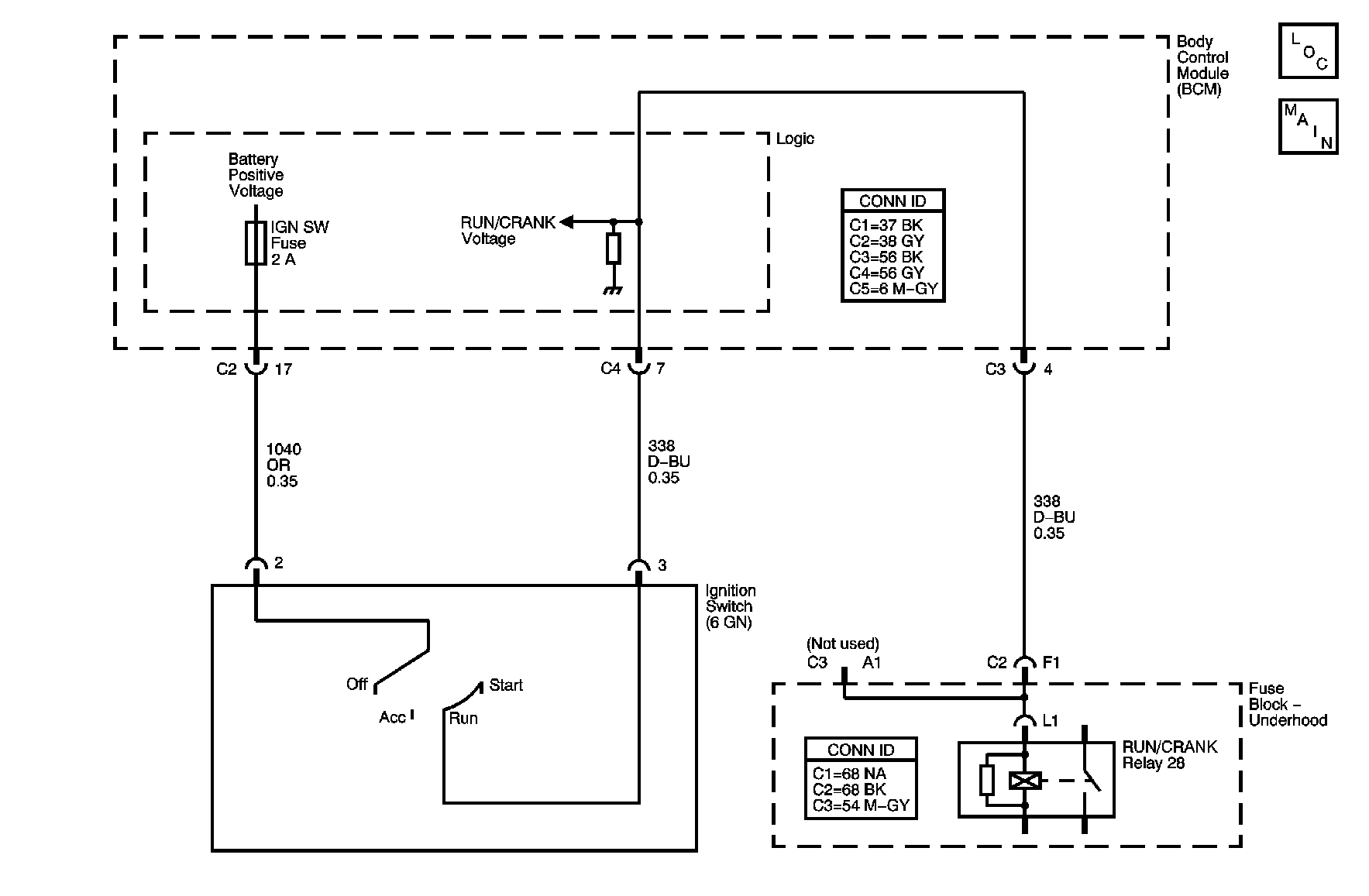
Circuit Description
The body control module (BCM), monitors the ignition inputs Off/Run/Crank, Run/Crank and the accessory signals supplied from the ignition switch. The BCM uses the sequence that the signals appear and their voltage levels to determine the power mode called for by the vehicle operator using the ignition switch. A fuse protected B+ voltage source is supplied by the BCM to the ignition switch over a discrete circuit. The ignition switch uses this voltage for Run/Crank signal discrimination. The Run/Crank signal is also routed to the vehicles Run/Crank relay control coil.
DTC Descriptors
This diagnostic procedure supports the following DTCs:
| • | DTC B1372 Device Ignition 1 (ON and START) Circuit Low |
| • | DTC B1373 Device Ignition 1 (ON and START) Circuit High |
| • | DTC B1374 Device Ignition 1 (ON and START) Circuit Open |
Conditions for Running the DTC
| • | The BCM must be powered and must detect a change in the ignition switch circuit states. |
| • | The vehicles battery must be fully charged. |
Conditions for Setting the DTC
DTC B1372
The BCM detects that the Run/Crank signal is shorted to ground for more than 10 seconds in the current ignition cycle.
DTC B1373
The BCM detects that the Run/Crank signal is shorted to B+ for more than 10 seconds in the current ignition cycle.
DTC B1374
The BCM does not detect the Run/Crank signal for more than 10 seconds in the current ignition cycle.
Action Taken When the DTC Sets
| • | The BCM stores DTC to memory. |
| • | The BCM operates in a fail-safe power mode dependent on the last valid power mode detected and the state of the engine run flag data on the class 2 serial data communications circuits. |
| • | The other modules on the vehicle operate in a fail safe power mode dependent on the last valid power mode transmitted by the BCM and the state of the engine run flag on the class 2 serial data communications circuits. |
Conditions for Clearing the DTC
| • | A current DTC clears on the next malfunction free cycle. |
| • | A history DTC clears when the module ignition cycle counter reaches the reset threshold, without a repeat of the malfunction. |
Diagnostic Aids
A history DTC maybe caused by an intermittent short or open in the Off/Run/Crank circuit. Refer to Testing for Intermittent Conditions and Poor Connections in Wiring Systems.
Test Description
The numbers below refer to the step numbers on the diagnostic table.
-
This tests the ignition switch for a short circuit between the B+ supply circuit and the Run/Crank circuit in the Off position.
-
This tests the wiring of the Run/Crank circuit for a short to ground or voltage. This test may be expedited using the DTC to direct the testing. DTC B1372 short to ground or DTC B1373 short to voltage.
-
This tests the ignition switch for a closed circuit between the ignition switch B+ supply circuit and the Run/Crank circuit in the Run and Crank switch positions. Care must be taken as the engine may crank during this test.
Step | Action | Yes | No | ||||
|---|---|---|---|---|---|---|---|
Schematic Reference: Body Control System Schematics Connector End View Reference: Computer/Integrating Systems Connector End Views and Master Electrical Component List in Wiring Systems | |||||||
1 | Did you perform the Diagnostic System Check - Vehicle? | Go to Step 2 | Go to Diagnostic System Check - Vehicle in Vehicle DTC Information | ||||
2 |
Does the scan tool display DTC B1372 to DTC B1374 as current? | Go to Step 3 | Go to Diagnostic Aids | ||||
Did you find a short between the two circuits? | Go to Step 4 | Go to Step 5 | |||||
Did you find and correct the condition? | Go to Step 9 | Go to Step 7 | |||||
|
Important: The engine may crank during this procedure.
Can you measure continuity in both Run and Crank? | Go to Step 8 | Go to Step 6 | |||||
6 | Test the Run/Crank and the ignition switch B+ supply terminals of the ignition switch harness connector, for intermittent or poor connections, and an open condition. Did you find and correct the condition? | Go to Step 9 | Go to Step 7 | ||||
7 | Replace the ignition switch. Refer to Ignition Lock Cylinder Case Replacement in Steering Wheel and Column. Did you complete the replacement? | Go to Step 9 | -- | ||||
8 | Replace the BCM. Refer to Control Module References for replacement, setup, and programming. Did you complete the replacement? | Go to Step 9 | -- | ||||
9 |
Does the DTC reset? | Go to Step 1 | System OK | ||||
